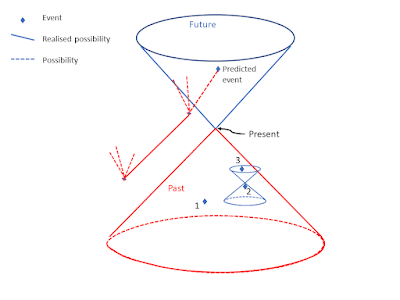The previous post introduced the ETH (Events, Trees and Histories) approach to the foundations and completion of quantum theory. This post addresses why it is impossible to use a physical theory to predict the future and why quantum mechanics is probabilistic although the Schrödinger is deterministic.
Impossibility of prediction
The diagram uses the standard light-cone representation of space-time. The Future is at the top and the Past at the bottom. The predictor sits at the Present and has in principle access to all information in their Past light-cone. That is, they can access information on all past events but no information on what happens outside their Past light-cone. There is causal structure within the Past light-cone. Events 1 and 2 are space-like separated. They cannot influence each other. Event 3 is in the future of 2, so event 2 can influence 3. Of significance for the argument are the events outside the predictors light-cones (Future and Past) that are in the past light-cone of the predicted event. These events can influence what happens at the space-time point of the predicted event, but the predictor can have no knowledge of them. Therefore, the predictor cannot predict in principle what will happen at a future space time point. In practice it is common knowledge that prediction is seen to work many situations. These situations are controlled to isolate the predicted phenomenon from the influence outside the predictors control.
Indeterminacy of quantum mechanics
The probability measure describes a contingent mode of being for the quantum system with a spectrum of valued that are possible and become actual. What is missing is an understanding of the timing of the actualisation. In all the versions of quantum theory considered so far time behaves the same way as in classical physics.
While the question of timing is still to be resolved, quantum mechanics should be a theory that incorporates random events that are not derived from the deterministic evolution of the state. However, that evolution does govern the probabilities of becoming actual of property values associated with the spectrum of the self-adjoint operators representing the physical properties of \(S\).
It should be noted that Bohmian mechanics provides an alternative model in which the uncertainty of the outcome is due to uncertainty in the initial conditions for the dynamical evolution. In the Bohmian theory the uncertainty is epistemic, and the dynamics is deterministic. The Bohmian theory needs to introduce this uncertainty into an otherwise deterministic theory to obtain empirical equivalence to standard quantum mechanics.
The formulation of the quantum mechanics presented in this blog is, so far, consistent with the ETH approach [1]. Some aspects of special relativity have now been introduced even though a relativistic formulation of quantum mechanics has not been presented yet. This will be part of the formulation of a mathematical description of the quantum "event".
References
| \(\mbox{[1] }\) | Fröhlich, J. (2021). Relativistic Quantum Theory. In: Allori, V., Bassi, A., Dürr, D., Zanghi, N.(eds) Do Wave Functions Jump? . Fundamental Theories of Physics, vol 198. Springer, Cham. https://doi.org/10.1007/978-3-030-46777-7_19 |


No comments:
Post a Comment
Anonymous comments will not be published